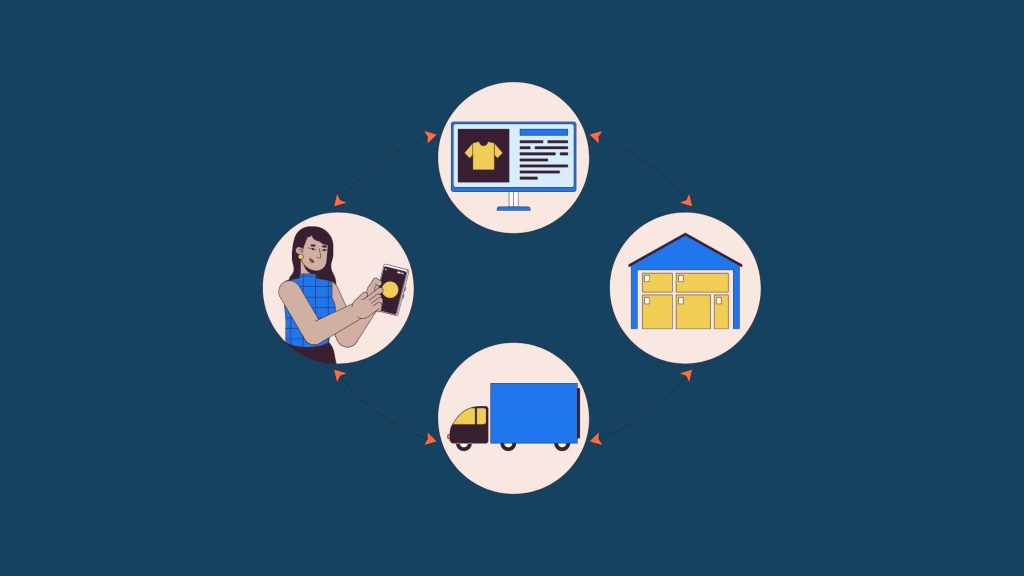Dropshipping vs Affiliate Marketing: Which is More Profitable? – Comprehensive Guide 2024
Dropshipping vs Affiliate Marketing : Choosing the right online business model is crucial, and two popular options for generating income online are dropshipping and affiliate marketing. Each has its advantages, drawbacks, and distinct characteristics, making it essential to evaluate both before deciding which one might be more profitable for you.
Table of Contents
This detailed essay will explore dropshipping and affiliate marketing in depth, comparing the two in terms of startup costs, income potential, operational requirements, marketing strategies, and scalability.
1. Understanding Dropshipping

What is Dropshipping?
Dropshipping is a retail fulfillment method where the seller doesn’t stock the products they offer. Instead, when a customer orders a product, the dropshipper purchases the item from a third-party supplier who ships it directly to the customer.
Also Read : How Dropshipping Works in India ?
This business model allows sellers to offer a variety of products without having to deal with inventory or fulfillment logistics.
Key Characteristics of Dropshipping:
- No Inventory: Sellers don’t need to stock products, which reduces the initial investment.
- Low Startup Cost: Since you don’t have to purchase products upfront, the startup costs are significantly lower compared to traditional retail.
- Direct Shipping: Products are shipped directly from the supplier to the customer, making it more convenient.
- Product Selection: You can quickly change or expand your product line by adding new products from suppliers.
2. Understanding Affiliate Marketing

What is Affiliate Marketing?
Affiliate marketing is a performance-based marketing strategy where an affiliate promotes a company’s product or service and earns a commission on every sale made through their unique referral link. Affiliates typically create content (blogs, reviews, videos) that attracts visitors to the company’s website, and if a visitor purchases something, the affiliate gets a commission.
Key Characteristics of Affiliate Marketing:
- No Product Handling: Affiliates do not have to manage products or handle customer service.
- Content Creation Focus: The primary role of an affiliate is to create high-quality content that draws traffic and encourages purchases.
- Passive Income Potential: Once content is created, it can continue to generate revenue passively if it attracts ongoing traffic.
- Wide Variety of Products and Services: Affiliates can work with multiple companies or brands across various industries, providing flexibility in content and niches.
3. Comparing Dropshipping and Affiliate Marketing
Startup Costs and Risks
- Dropshipping: The startup costs in dropshipping primarily involve setting up an e-commerce website, such as on Shopify, paying for a domain name, and possibly advertising. Although you don’t need upfront inventory, there are still costs associated with maintaining the website, handling payment processing, and paid advertising. The initial costs for a basic dropshipping store can range from $100 to $500, depending on the platform and tools used.
- Affiliate Marketing: Affiliate marketing generally has lower startup costs because you don’t need a physical storefront or inventory. A website, domain name, and possibly some basic digital marketing are usually enough to start. This cost might be even lower if you focus on free methods like SEO and social media rather than paid advertising.
Winner: Affiliate Marketing is often more affordable for beginners since it has minimal upfront investment and carries less financial risk.
Profit Margins
- Dropshipping: Margins are typically lower in dropshipping because you buy products from suppliers and resell them. With supplier costs, shipping fees, and marketing expenses, the profit margin in dropshipping can range from 10-30%. Competing on price while keeping a healthy profit margin can be challenging.
- Affiliate Marketing: The commission rate varies depending on the product or service and can range from 5% (for physical products) to 50% or even more (for digital products). Affiliates promoting digital products, such as courses or software subscriptions, often see higher commissions, sometimes up to 70%, which can translate to higher profit margins.
Winner: Affiliate Marketing generally offers higher profit margins, especially when promoting digital products with high commissions.
Income Potential
- Dropshipping: Since dropshipping is essentially a retail business model, its income potential is high. Many dropshippers report monthly sales in the thousands, depending on their niche, target market, and marketing success. However, profits depend on the pricing strategy and customer acquisition costs, which are typically higher.
- Affiliate Marketing: Income potential in affiliate marketing can also be substantial, especially if affiliates focus on high-ticket items or recurring commissions (such as software or membership programs). However, earnings can fluctuate based on traffic volume, SEO ranking, and the effectiveness of content.
Winner: Both have high-income potential, but dropshipping can generate consistent revenue once customer acquisition is optimized. However, affiliate marketing can lead to significant passive income over time as high-quality content continues to drive sales without active management.
Scalability
- Dropshipping: Scaling a dropshipping business is challenging. With more orders, you may need better inventory management, customer support, and faster order fulfillment, and suppliers may sometimes struggle to keep up with demand. Dropshipping businesses can scale with effective marketing, but there’s a need for reliable suppliers and possible fulfillment partnerships as sales grow.
- Affiliate Marketing: Affiliate marketing is highly scalable, especially if you generate content that ranks well on search engines. Scaling involves creating more content, improving SEO, and perhaps expanding to paid traffic channels. You don’t have to handle fulfillment, which makes scaling easier than dropshipping.
Winner: Affiliate Marketing is generally easier to scale, as it doesn’t involve managing inventory or fulfillment logistics.
4. Marketing Strategies
Dropshipping:
- Paid Advertising: Dropshipping stores often rely on paid advertising like Facebook, Instagram, or Google Ads to drive traffic quickly.
- SEO and Content Marketing: Some dropshipping stores also utilize blogs, product guides, or niche-focused content to attract organic traffic, though this requires a long-term strategy.
- Email Marketing: Building an email list helps dropshippers retarget customers, announce new products, and encourage repeat purchases.
Affiliate Marketing:
- SEO: Organic traffic through SEO is a primary strategy for affiliate marketers. Well-ranked content can drive ongoing sales without additional advertising costs.
- Content Marketing: Many affiliates focus on creating valuable content, such as blog posts, videos, and reviews, that helps readers make informed decisions.
- Social Media and YouTube: Affiliates often use platforms like YouTube, Instagram, and TikTok to reach a broader audience.
Winner: Affiliate Marketing has more options for low-cost marketing strategies, making it more accessible for beginners who may not have an advertising budget.
5. Customer Service and Management Requirements
- Dropshipping: Dropshippers are responsible for customer service, as buyers may have questions about orders, returns, and issues with the product. This can become time-consuming as sales increase.
- Affiliate Marketing: Affiliates aren’t responsible for customer service or product issues. Their role is to drive traffic to a merchant’s website, and any customer inquiries or complaints are handled by the company.
Winner: Affiliate Marketing is less demanding in terms of customer service and management, as affiliates are not involved in post-sale issues.
6. Which Model is More Profitable?

Factors Influencing Profitability:
- Niche Selection: Both models depend heavily on the niche. High-ticket items, low-competition products, or evergreen niches tend to generate more revenue for both dropshippers and affiliates.
- Time Investment: Dropshipping often requires ongoing management and customer support, while affiliate marketing involves upfront content creation that can generate passive income over time.
- Advertising Costs: Dropshipping’s reliance on paid advertising can reduce profitability, especially if customer acquisition costs are high. In contrast, affiliate marketing can benefit from organic traffic that’s cost-effective.
Dropshipping vs Affiliate Marketing – Conclusion:
Both dropshipping and affiliate marketing have the potential to be profitable. Affiliate marketing may be more appealing for beginners or those looking for a low-maintenance income stream with high passive earning potential. However, dropshipping can provide substantial revenue when scaled correctly, though it requires more hands-on management and upfront investment in advertising.
Buy Now : Ecommerce Website + Android App
Ultimately, the choice depends on your skills, budget, and long-term business goals. If you enjoy content creation and SEO, affiliate marketing may suit you better. If you’re skilled at digital advertising and customer service, dropshipping could be a more profitable avenue.
Keywords : Dropshipping vs Affiliate Marketing – Dropshipping vs Affiliate Marketing 2024 – Dropshipping vs Affiliate Marketing 2025



